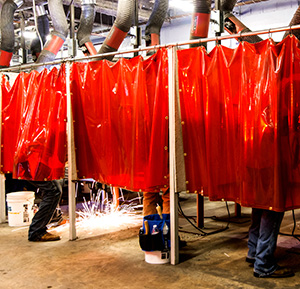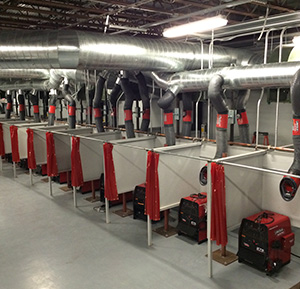TWS is a Great Training Option for Everyone
Learn more about how we can prepare you to advance your career.
If you’ve made up your mind to fuse metal for a living, then you’ve tackled the toughest part. Choosing a career. What’s next?
There is more than one path to becoming a welder.
- A dedicated welding training program at a trade school
- Welding courses at a community college
- On-the-job training[1]
- A welding apprenticeship
How do you decide which is right for you? Comparing the type of instruction each option offers, how long it takes, the qualifications of the teachers and quality of the equipment and the cost can help you weigh your welding training options.
Comparing Your Welding Training Options
Unless you took shop class in high school, the wide world of welding is probably totally new to you.
Have You Considered a Career in the Skilled Trades?
Fill out the form to recieve a no obligation info packet.
Welding training can help introduce you to the practices, tools and techniques of the trade. Below is a look at what some of the most common training options could hold in store for you.
Welding Training Focus
Welding School

As the name suggests, this training option focuses on one subject: welding.
The goal of welding schools is to make graduates career-ready. This means hands-on training on the same kind of equipment used in the field.
Students spend most of their time in the lab receiving hands-on training in the core arc welding processes used across the industry. They graduate with skills that are applicable to a range of entry-level positions:
- Structural welding
- Aircraft welding
- Pipe welding
- Thin alloy welding
Pros
- + Learn by doing
- + Smaller class sizes
- + Career-focused curriculum
- + Flexible scheduling
- + Market-calibrated programs
Cons
- − Singular focus on welding
- − Not the best choice if you’re undecided on a career in welding
Community College
If you’re not sold on a career in welding and want to explore other fields, community college could be a good fit for you.
This is typically a less-focused training path. You could take welding courses while trying out other trades like carpentry.[2]
Associate degree programs usually require students to take general education courses, such as math and writing. Classes in drafting, safety, reading and metallurgy might also be required for a welding degree.[3]
Credits or degrees earned at a community college can often be applied toward a traditional degree at a university.[4]
Pros
- + Exposure to different subjects
- + Course credits can be transferred to a university.
Cons
- − Less focused on welding
- − General education classes required
On-the-Job Training
Some employers are willing to train applicants on the job, but most prefer those with formal welding training. It’s not uncommon for new hires with formal training to spend several months receiving on-the-job training.[5]
This is because employers might want them to learn skills specific to the job. And that’s exactly what you’ll learn if receiving welding training from a company.
The training might not be as well rounded as at a welding school, however, and this could be a problem if you want to change jobs or work in other fields of welding.
Pros
- + Work while you train.
Cons
- − Learn a limited welding skillset.
- − Skills may not transfer to other companies easily.
Apprenticeship
An apprenticeship is another option that allows you to “earn and learn” at the same time. Companies and labor unions typically run these programs. Apprentices usually work during the day and then attend night classes. They get a good understanding of the hours, physical demands and expectations of the job, which is unique from welding school or community college.
Similar to on-the-job training, the skills learned may be limited to what’s required by the company.[6] The U.S. government doesn’t list welding as an apprenticeable occupation, so it may be difficult to find a program focused on welding only.
For example, plumbing apprentices may learn to weld, along with other skills needed for this profession.[7] Travel is frequently required to work on jobs in different locations—that’s why these workers are called “journeymen.”[8]
Some apprenticeships test applicants on math and hand tool use before allowing them to join the program.[9] Entry can be competitive and waiting lists are common.[10]
Pros
- + Earn while you learn.
- + Work experience
Cons
- − Can be difficult to get in
- − Commitment to a company or union
- − Bigger time commitment
- − More generalized training
Welding Training Time
Welding School

- 7 months – 2 years[11][12]
Community College
- 2 years – 6 years
- Learn more in Community College vs. Trade School: Career Training Comparison.
On-the-Job Training
- Depends on employer
Apprenticeship
- 1 – 6 years
- Typically, 3 years for welding[13]
Quality of Instruction and Equipment
Welding School
- Professional, experienced instructors[14]
- Specialized training facilities with updated equipment
Community College
- Instructors may have more generalized experience with welding.
- Programs and equipment may be dated.[15]
On-the-Job Training
- Instruction can be poor because it’s often provided by other employees. This is problematic if safety procedures aren’t taught properly.[16]
- The equipment provided would be specific to the job and could be dated.
Apprenticeship
- The quality of training and tools can depend on the master tradesman. He or she may employ older tools and methods.[17]
Greater Skills Equal More Career Opportunities
When choosing a welding training path, it’s important to consider training time, cost, what you’ll learn and the quality of the instruction and equipment.
These factors can help determine whether you want to pay a little more for a streamlined training approach, experiment with other subjects while learning to weld or spend longer to earn while you learn.
When it comes to preparing for a welding career, the more you know how to do, the greater the value you offer to potential employers. Select the training path that will best equip you for success in the field.[18]
Learn more about the possibilities after welding training in Where Could a Welding Job Take You?
- https://learn.org/articles/Welding_Become_a_Welder_in_5_Steps.html
- https://mystudentvoices.com/trade-school-vs-community-college-which-is-right-for-you-bd39f652c319
- https://learn.org/articles/Welding_Become_a_Welder_in_5_Steps.html
- https://study.com/blog/trade-school-vs-community-college-what-s-the-difference.html
- https://www.bls.gov/ooh/production/welders-cutters-solderers-and-brazers.htm#tab-4
- https://education.seattlepi.com/trade-school-vs-apprenticeship-3413.html
- https://www.dol.gov/apprenticeship/industry/pdf/Construction-Fact-Sheet.pdf
- https://app.aws.org/forum/topic_show.
- www.weldersunive
- https://app.aws.org/forum/topic_show.pl?tid=31005
- https://www.tws.edu/programs/professional-welding-training/
- https://www.thesimpledollar.com/why-you-should-consider-trade-school-instead-of-college/
- https://learn.org/articles/How_Long_is_Apprenticeship_Training_Typically.html
- https://www.tws.edu/blog/skilled-trades/career-colleges-vs-community-colleges-for-skilled-trades-training/
- http://www.weldersuniverse.com/welder_schools_tips3.html
- https://www.referenceforbusiness.com/encyclopedia/Oli-Per/On-the-Job-Training.html#ixzz5RUd8x4nW
- https://education.seattlepi.com/trade-school-vs-apprenticeship-3413.html
- http://www.careersinwelding.com/students.php
This blog has been labeled as archived as it may no longer contain the most up-to-date data. For a list of all current blog posts, please visit our blog homepage at https://www.tws.edu/blog/







